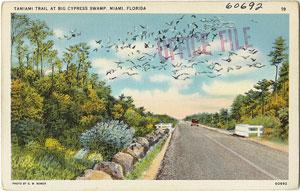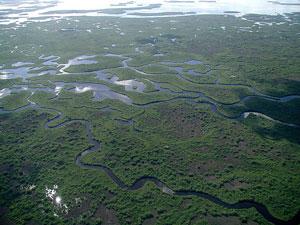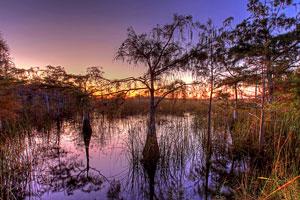In 1928 a highway known as the Tamiami Trail was built across the southern Florida peninsula, and while it was a boon for developers, the dam-like roadfill created serious problems for Everglades National Park. A partial solution'replacing some of the road's berm with bridges'got a welcome boost with a recent pledge of $90 million from the State of Florida.
On August 28th, Florida Governor Rick Scott announced the state's commitment of $30 million a year over three years to help replace a 2.6-mile section of existing highway berm with a bridge along the northern boundary of Everglades National Park. The state dollars are being offered as a match to a similar $90 million investment in federal dollars.
The total estimated cost'$180 million'is a sizeable chunk of money, but unlike some other highway projects derided as a "bridge to nowhere," this one would offer a solution to several closely-related problems.
Fresh Water Once Flowed Freely Across Southern Florida
In the late 1800s, the southern end of the Florida peninsula was largely undeveloped, and although the area was a rich and complex ecosystem, it was viewed by some as merely wasted "swampland." Fresh water'including sometimes copious amounts from tropical storms'flowed freely southward as a shallow, slow-moving sheet of water through the large but shallow Lake Okeechobee, and then onward through the Everglades to coastal estuaries and the sea.
The area's mild winter climate made it attractive for residential and agricultural development and tourism, but the problem was what to do about all that "swamp." The answer was decades of construction of an elaborate system of dikes, canals and pumping stations to drain wetlands and try to control flooding'not an easy task in this relatively flat terrain.
An East-West Highway was a Key to Development of South Florida
It was a classic example of "if you build it, they will come," and much of south Florida is now both a major agricultural empire and home to millions of people. A key missing link for that development in the early 1900s was a highway linking Miami on the state's east coast with Naples on the west.

The Tamiami Trail as shown in a postcard from about 1940. Boston Public Library Photo.
The answer was a road known as the Tamiami Trail (now US 41), and to keep construction costs down, the primary technique was to simply bring in fill, build a very long berm, and lay a roadway on top.
The natural flow of freshwater southward through what's now Everglades National Park was interrupted, and the result was a host of unintended consequences to what the park website described as a delicately-balanced "mosaic of ponds, sloughs, sawgrass marshes, hardwood hammock, and forested uplands."
Everglades National Park Now Relies Upon "Engineered" Water
Everglades National Park is a relative newcomer to this story; the park was established in 1947 to conserve some of the remaining natural area, and includes about 1.5 million acres out of about 18,000 square miles in the original Everglades ecosystem. A short paragraph on a park map sums up the challenge: "Fresh water flowing into the park is engineered. With the help of pumps, floodgates, and retention ponds along the park's boundary, the Everglades is presently on life support, alive but diminished."
And that brings us back to the State of Florida's offer of $90 million to help replace 2.6 miles of that Tamiami Trail berm with a bridge. Ironically, impetus for the state's support for the project came from a summer with too much rain in southern Florida, and a press release from the Governor's office helps explain the problem.
"Today's setup of the Tamiami Trail inhibits water flow, which forces more storm water runoff to drain from Lake Okeechobee into the Caloosahatchee and St. Lucie estuaries, instead of flowing south through the Everglades. By constructing an additional bridge, more water will be able to flow naturally through the Everglades, which will keep nutrient rich water out of the estuaries."
Excess Water in Lake Okeechobee Causes Big Problems
Swollen by unusually heavy spring and summer rains, Lake Okeechobee is literally on the verge of bursting at the seams. In the 1930s, a 143-mile long earthen dike was constructed around the lake to regulate water levels, and the Army Corps of Engineers, fearing failure of the aging levee, has released tens of billions of gallons of fresh water from the lake into estuaries to the east and west.
The deluge of not-so-clean water has upset the delicate balance of salt and fresh water in the estuaries and fouled water quality in areas with important commercial crops of oysters and other shellfish. The water in some areas has become unsuitable for swimming, game fish are disappearing, and businesses that depend on tourism are hurting.
Those problems spurred the state's recent announcement of help for the Tamiami bridge project. According to Governor Scott, 'This $90 million investment will be a huge step forward in our efforts to restore water quality throughout South Florida. Every drop of water that we can send south and keep out of the Caloosahatchee and St. Lucie Estuaries is a win for Florida families."
Economic Losses from High Water Spur State Support for Bridge Project
A number of state politicians also expressed their support, including Representative Dane Eagle, who said, 'The ultimate completion of the Tamiami Trail projects will be a game changer for water quality in South Florida. By Governor Scott taking steps forward in completing another major segment, Florida is becoming more proactive in its efforts to create a more sustainable environment for future generations. With this $90 million investment, we're not only committing to restoring water quality, but we're supporting Florida's future economic strength.'

Water is essential to the ecology of Everglades National Park. NPS photo.
The bridge work is only a small part of a much larger regional Comprehensive Everglades Restoration Plan, and the project would also be a win for the park, where the Governor's announcement was welcome news.
'One of the most critical components of the Everglades restoration is increasing water flow under Tamiami Trail into Everglades National Park,' said Superintendent Dan Kimball.
'This is a crucial step forward in the Everglades restoration, and we are very thankful to the governor for the commitment he demonstrated today to the Everglades restoration and to the key part it plays in Florida's economy.'
Everglades Restoration Depends on Partnership
'Several significant advances have been made recently that demonstrate the protection of America's Everglades remains a national and state priority,' said Park Superintendent Kimball, 'and that the federal/state partnership necessary for our success is very active in moving forward together.'
Secretary of the Interior Sally Jewell also issued a statement praising the state's offer. 'We welcome Governor Scott's partnership with the Department in the construction of a 2.6- mile bridge on the Tamiami Trail, a critical next step in our collective efforts to restore the Everglades,' Jewell said.
'Bridging the Tamiami Trail is a key component of Everglades' restoration plans to increase water flow through the central Everglades into Everglades National Park and Florida Bay," Jewell noted. "This will both help restore wildlife habitat in the Everglades and improve flood conditions in the Water Conservation Areas north of the trail."

Everglades National Park. NPS photo by G. Gardner.
Proposed Bridge is Phase Two of the Project
The state money would help fund the second phase of an eventual 6.5 miles of bridging planned for the Tamiami Trail. The first step in the project was completed in February of this year, when the National Park Service and the U.S. Army Corps of Engineers completed construction of the first mile of bridge on the Trail.
Congress authorized an additional 5.5 miles of bridges along the trail in 2011'but that vote did not provide the funding to do the work. The Department of the Interior is seeking $30 million in its 2014 budget to help begin the work'and provide the needed dollars to match the state's contribution'but that request will have to compete with many other projects in a time of tight federal dollars.
The State of Florida has stepped in to cut the federal cost of the next phase of the project in half. Now the question is whether this plan for a "bridge to somewhere" will go anywhere in a Congress distracted by partisan divisions over bigger budget issues.




Comments
I always thought the saying" Beating a dead horse" was kind of a humorous antedote....
I have Video Evidence of Taxpayer Dollars Wasted on the Everglades Bridging.
We have been lied to and led to believe that the new 1 mile bridge is working, but we have video evidence that it is not working. The 2.6 mile bridge is next to be built before even testing the new 1 mile bridge. This bridge will be a huge disaster. The negative effects the new proposed 2.6 mile bridge will be irreversible. We the people have the power to stop the corruption, and irresponsible decisions that are being made behind our backs. We will show you the truth about how taxpayers are about to lose billions of dollars, and how wildlife will pay with their lives.
http://www.youtube.com/watch?v=16fxd6arpxo
Please watch, share, and repost the video in your blogs, news feed, social pages, and etc.
miamiglademan, I did watch the video, I probably know so little about the issue, I should say, well, not much, except I have driven the highway, seen the canal and was told by friends working in the Everglades it was affecting the park ecosystem along with urban sprawl and ag issues. I had a little trouble understanding the video, but thank you posting. I do give much credence to the Everglades Supt. and others in the article that state this is a positive step. Politically, I am no fan of Governnor Scott, but I think his support of this effort is a step in the right direction.